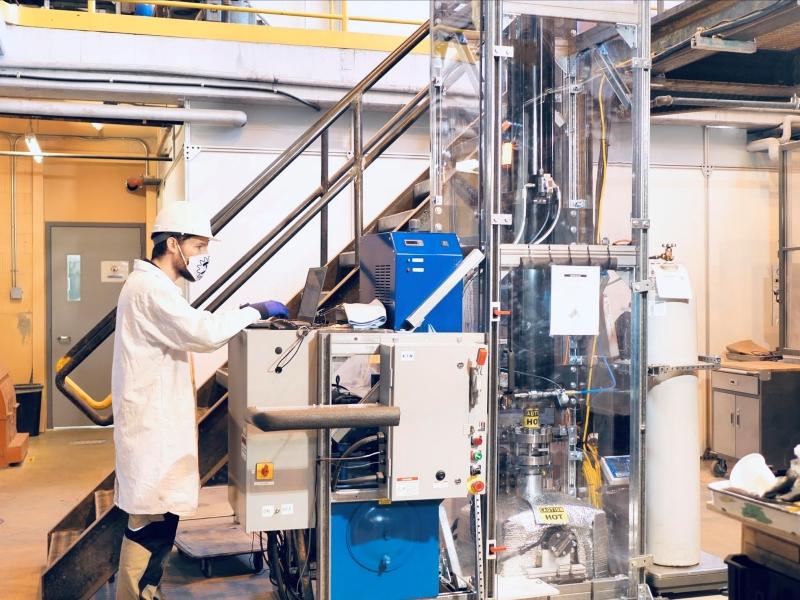
The Barrett Centre for Technology Innovation at Humber College is net-zero energy and seeking a LEED Platinum certification. (Courtesy Humber College)
Windows open on their own at the Barrett Centre for Technology Innovation (CTI) … and it’s not a mistake.
Natural ventilation is just one of the cutting-edge sustainability features incorporated into the 93,000-square-foot smart building. The net-zero energy building opened in Toronto at Humber College’s north campus in April 2019.
“I think people expect our new construction to be built this way going forward,” said Humber’s manager of energy efficiency Aman Hehar, adding “it was the bare minimum for us.”
The Barrett CTI was built to meet LEED-Platinum certification standards from the Canada Green Building Council (CaGBC). Hehar said that certification is “imminent,” and likely to be announced before the end of the year.
The project cost $51 million and energy efficiency was a key in all aspects of the design and construction; “There’s probably 50 to 80 different things you can do to go after [LEED] points,” Hehar said.
Barrett CTI features
Sustainability features include a passive heating and cooling system, high-performance roofing system, hydronic in-floor heating, and a green roof.
“We wanted the building to embody sustainability and energy efficiency,” Hehar said. In terms of aesthetics, they’re “trying to expose the systems and the elements of the building … you can follow piping and cabling throughout the building,” he said
There are even ‘truth windows’ which allow a look into the building’s inner workings. In several locations where there would normally be an opaque wall, at Barrett CTI “there’s a piece of plexiglass or something you can see through to show off a building element or a piece of equipment,” Hehar said. “In some places, you can see some pumps or pipe.”
A thermal chimney allows air to get “drawn in from the windows and up through the building and it takes the heat with it … it’s good that you don’t have to use any mechanical cooling,” he said.
In creating a net-zero energy building, “the intent was to get the energies down as low as possible, and then supplement the rest, any energy the building would use, through solar photovoltaics,” he said.
‘Mind-blowing’ solar panel system
Timing worked in favour of the Humber College project as a 1,000-spot parkade was being built on an adjacent property at the same time.
“Instead of actually putting the panels on the CTI, we put them on right beside it on the parking structure,” said Hehar. The parkade “was perfect for it, lots of space.”
A 700 kilowatt DC system is being used and “it’s a really low energy-using building, but when you see how many panels it takes to make it zero energy … it’s mind-blowing,” said Hehar. “It’s a pretty big structure and it covers the entire roof.”
Some statistics about the Barrett CTI building:
* There are 1,832 400W solar panels on the adjacent parking structure which net out the energy consumption of the Barrett CTI;
* Total system capacity is 580kW-AC;
* The building is designed to use less than 100kWh/m2/yr of energy use;
* That’s roughly 65 per cent less than an average building on the Humber campus;
Other places on campus have daylight harvesting sensors, or lighting where “when it’s sunny out, the lights will dim down and people will say ‘the lights are out.’ They’re supposed to turn off when the sun’s up, and the space is bright enough on its own,” said Hehar.
It will take some time, he said, for these features to become mainstream.
“People just aren’t used to these things yet, which was fun. The fun part [is] it’s a learning opportunity.”
Major retrofit at NX building
Humber is also wrapping up a major retrofit to the existing NX building on campus. Back in May, it was certified zero carbon, he said, making it “the first zero-carbon retrofit in Canada.”
With a design certification under its belt, Passive House certification for NX is next.
Passive House (Passivhaus) is “considered to be the most rigorous voluntary energy-based standard in the design and construction industry today,” according to information posted on its website.
“So we’re really excited about that one,” Hehar said. “It’s super low-energy.”
The furnace in particular in the NX building is something to brag about.
“The size of the furnace that you’d use to heat that building is probably about the size of the furnace at my house, it’s just incredible,” said Hehar. “It’s a five-storey 50,000 square foot building.”
At the end of the day, “it’s great to build a sustainable building but we’re also teaching the future workforce,” Hehar said. “We want our students to be learning in world-class buildings, but we also want them to be able to experience the buildings and learn from them.”
About the Barrett CTI project
* The catalyst for the Barrett CTI was a $10 million investment from The Barrett Family Foundation, the largest private donation in Humber’s history.
* This commitment also supports student awards and scholarships, skills mentorship programs and equipment and technology.
* Additional funding was provided by the Government of Canada, which contributed $15.5 million from the Post-Secondary Strategic Investment Fund, and the Government of Ontario, which supported the purchase of key equipment within the building through $1.55 million from the College Equipment and Renewal Fund.







